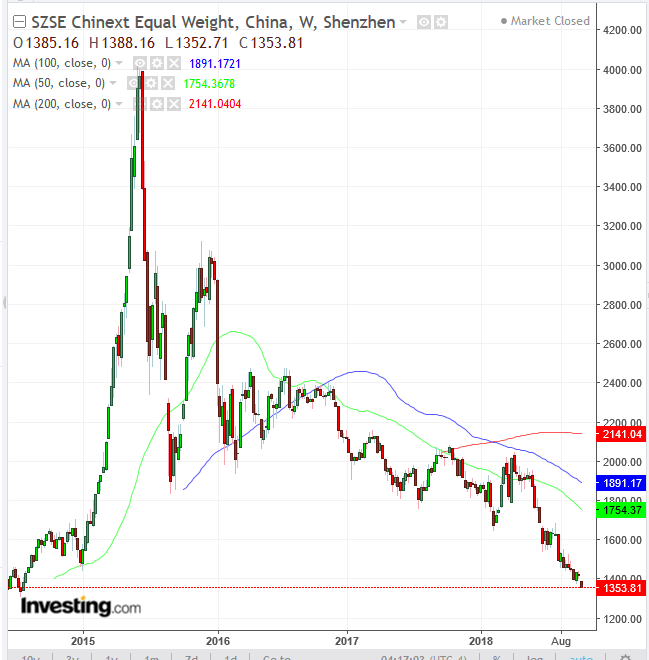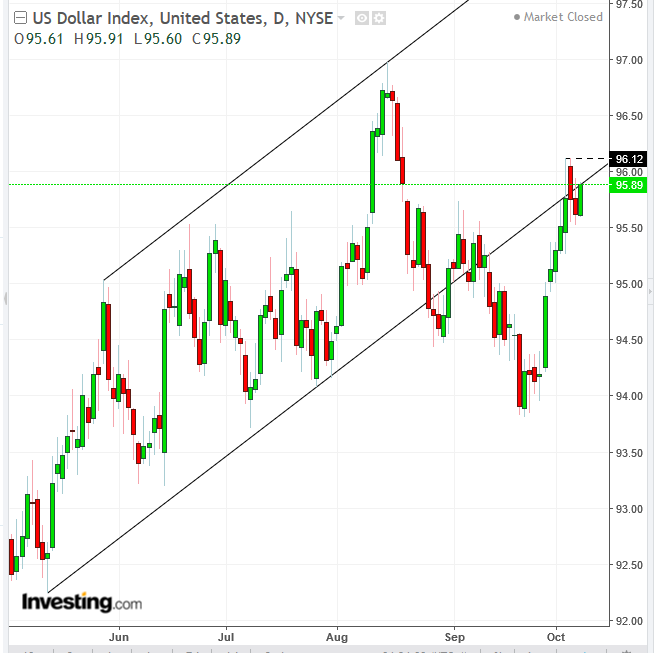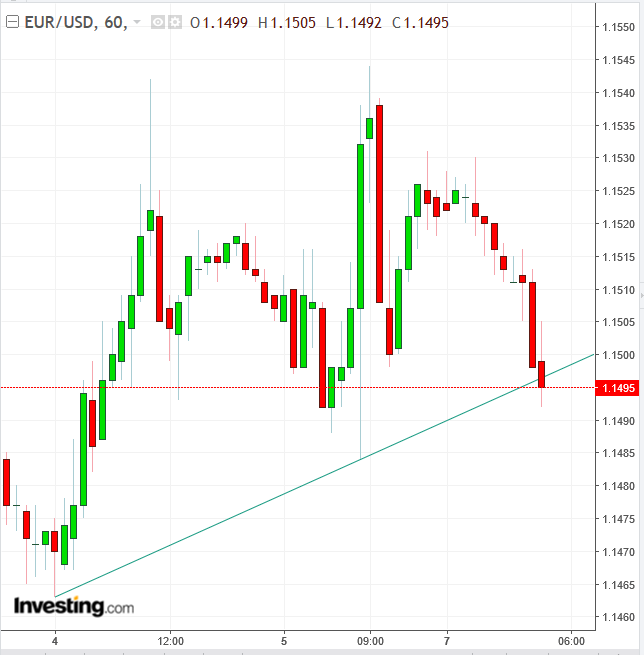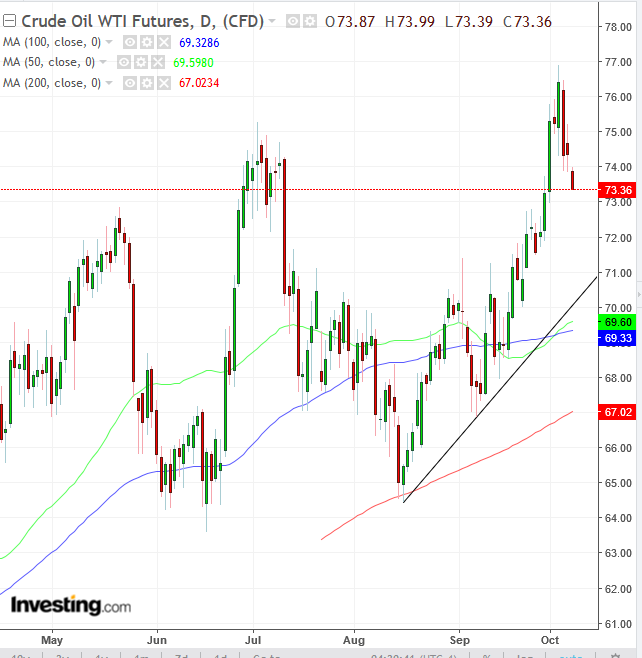-
Italy's budget standoff with European Commission adds to broader rotation into risk-off
-
China's central bank intervention hits Asian shares, yuan
-
Potential US waivers on Iranian sanctions weighs on WTI
Key Events
European equities, along with futures on the S&P 500, Dow and NASDAQ 100, followed Asian shares lower this morning amid heightened risk-off sentiment.
While the Columbus Day holiday in the US has given Treasurys some respite from last week's selloff which pushed them to a 7-year low as US bond markets are closed today, Italy's sovereign bonds continue to be dumped by investors after the country's nationalist government clashed with the European Commission over its budget plans, sending the yield on 10-year notes to its highest levels since February 2014.
The pan-European STOXX Europe 600 slipped lower for a third straight day, weighed down by losses in automakers and retail shares as well as re-ignited fears over the possible ramifications of Italy's euroskeptic stance.

During the earlier Asian session, Chinese stocks underperformed. The China A50 plunged 4.81 percent, the SZSE Component slid 4.05 percent to the lowest level since July 2014 and the Shanghai Composite tumbled 3.72 percent. These vigorous losses occurred after the People's Bank of China cut reserve requirements for banks for the fourth time this year, unlocking $109.2 billion of funds to prop up the country's economy, which has come increasingly under pressure from mounting trade tariff risks .
The move pushed the Chinese yuan below 6.9 per dollar in the offshore market, with the dollar side benefiting from an increased outlook for interest rate tightening, after fresh US data showed on Friday that unemployment in the world's largest economy hit the lowest level in almost 50 years.
Japan was spared the volatility. Its markets were shut for Health-Sports Day.
Global Financial Affairs
On Friday, US equities capped their worst week in a month, with technology shares leading the decline, pulling the NASDAQ 100 1.21 percent lower, off 3 percent for the week, amid persistent trade headwinds.
A 7-year high for 10-year Treasury yields added to the equity exodus, spurring investors to sell riskier growth assets in favor of safer—and now higher-yielding—bond holdings.

The dollar also got a boost from growing foreign demand for USD-denominated Treasurys. The greenback is struggling for the third day, at the bottom of the rising channel it violated. Since the price is now chasing the rising channel bottom, it may require a new high, above the 96.98, August 15 peak, confirming the uptrend, which would make technical traders comfortable with committing to a long position.

The euro has been falling, with underwhelming German industrial production figures adding to the already existing political headwinds. Technically, the single currency has been caught between supply and demand on the uptrend line since Thursday.
South Africa’s rand weakened on reports the country's Finance Minister Nhlanhla Nene intends to resign over a recent corruption scandal.

In commodities markets, West Texas Intermediate oil slid below $74 a barrel after Washington said it might allow some waivers on Iranian crude purchases for countries that have demonstrated efforts to reduce imports from the Middle-Eastern oil producer. Technically, the price of WTI could still fall toward $71 without its trend’s integrity being questioned.
Aluminum prices eased considerably after Norwegian metals company Norsk Hydro ASA (OTC:NHYDY) reversed a decision to close the world’s largest alumina refinery, the Brazilian Alunorte, which had added to ongoing fears of supply scarcity.
Up Ahead
-
The US Treasury auctions $230 billion worth of debt this week.
-
The International Monetary Fund presents its World Economic Outlook on Tuesday.
-
US President Donald Trump holds the latest series of rallies this week ahead of the November 6 mid-term elections.
-
US consumer prices, due on Thursday, are expected to have remained elevated in September, climbing 2.3 percent from a year earlier.
-
JPMorgan Chase (NYSE:JPM)., Citigroup (NYSE:C) and Wells Fargo (NYSE:WFC) kick off earnings season for US banks on Friday.
Market Moves
Stocks
-
The STOXX Europe 600 declined 0.2 percent to the lowest level in almost four weeks.
-
Futures on the S&P 500 fell 0.2 percent to the lowest level in four weeks.
-
The Shanghai Composite Index dropped 3.7 percent, hitting the lowest level in almost three weeks.
-
The MSCI Emerging Market Index slipped 0.8 percent.
Currencies
-
The Dollar Index gained 0.3 percent.
-
The euro fell 0.2 percent.
-
South Africa’s rand lost 1.1 percent to the weakest level in more than three weeks.
-
The offshore yuan declined 0.2 percent to 6.907 per dollar, reaching the weakest level in almost eight weeks.
Bonds
-
Italy’s 10-year yield climbed eight basis points to 3.504 percent, the highest level in more than four years.
-
Germany’s 10-year yield slid one basis point to 0.56 percent.
-
Spain’s 10-year yield gained one basis point to 1.586 percent, the highest level in almost 19 weeks.
Commodities
-
The Bloomberg Commodity Index fell 0.4 percent.
-
West Texas Intermediate crude slipped 0.8 percent to $73.74 a barrel, the lowest level in more than a week.
-
LME copper declined 0.1 percent to $6,164.00 per metric ton, the lowest level in more than two weeks.
-
Gold edged 0.6 percent lower to $1,196.08 an ounce.
